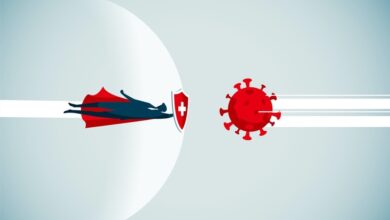
5 Steps Towards Corporate Resilience Amid Coronavirus Crisis
5 steps towards corporate resilience amid coronavirus crisis: Navigating the complexities of a global pandemic requires proactive strategies to ensure business continuity and long-term success. This article delves into five crucial steps companies can take to build resilience and thrive in the face of future crises, drawing on lessons learned during the COVID-19 pandemic. From defining corporate resilience and creating strategic plans to fostering employee well-being and engaging stakeholders, we explore practical methods and real-world examples to empower businesses to weather any storm.
The first step is defining what corporate resilience means in a crisis like the coronavirus pandemic, exploring its characteristics and why it’s essential for organizations. This will be followed by discussing strategic planning, including contingency planning and scenario analysis, as well as vulnerability assessments and stakeholder relationships. The next crucial element is operational agility and adaptability, encompassing digital transformation, flexible work arrangements, and practical steps to ensure business continuity.
Robust financial and resource management strategies, including financial modeling, revenue diversification, and cash flow management, are also key components. Finally, we examine the significance of employee well-being and engagement, along with stakeholder engagement and communication strategies.
Defining Corporate Resilience
Navigating crises like the COVID-19 pandemic demands a new level of preparedness and adaptability for businesses. Corporate resilience isn’t just about weathering the storm; it’s about thriving through it and emerging stronger. It’s about anticipating challenges, proactively mitigating risks, and rapidly adjusting strategies to maintain operational stability and profitability. This proactive approach is crucial for long-term sustainability.Resilient organizations aren’t immune to setbacks, but they possess the capacity to absorb shocks, adapt quickly, and bounce back with renewed vigor.
These qualities are built into the very fabric of the company, allowing for swift recovery and sustained performance even during challenging periods.
Defining Corporate Resilience in Crisis
Corporate resilience in the context of a crisis like the coronavirus pandemic is the ability of a company to anticipate, absorb, adapt to, and recover from disruptions. This encompasses not only operational efficiency but also the ability to maintain employee morale, adapt to changing market conditions, and effectively communicate with stakeholders. Resilience is a dynamic process, requiring ongoing evaluation and adaptation.
When investigating detailed guidance, check out cima ethics confidentiality rules now.
Key Characteristics of Resilient Organizations
Resilient organizations exhibit several key characteristics that differentiate them from their less-prepared counterparts. These distinguishing features are critical to understanding how to build resilience into a business strategy.
- Proactive Risk Management: Resilient organizations proactively identify potential risks and develop contingency plans to mitigate their impact. This includes anticipating disruptions like supply chain disruptions, economic downturns, or public health crises.
- Strong Leadership and Communication: Effective leadership is paramount during crises. Resilient organizations have leaders who communicate clearly and transparently with employees, stakeholders, and the public, fostering trust and maintaining morale.
- Adaptable Operations: Resilient organizations are flexible and agile in their operations. They can quickly adjust to changing circumstances, whether it’s shifting to remote work, adapting supply chains, or pivoting product offerings to meet new demands.
- Employee Well-being: Recognizing the emotional toll of a crisis, resilient organizations prioritize employee well-being and provide support during challenging times. This includes mental health resources and flexible work arrangements.
- Strong Financial Position: A strong financial foundation is critical for weathering any crisis. Resilient companies maintain healthy cash reserves, explore financing options, and manage expenses effectively to navigate uncertainty.
Importance of Proactive Resilience Building
Building corporate resilience is not a reactive measure, but a proactive investment in long-term sustainability. A resilient company is better positioned to capitalize on emerging opportunities and overcome unexpected challenges. It’s about anticipating future uncertainties and preparing for them. By investing in resilience, companies are essentially investing in their future success.
Examples of Resilience During the Pandemic
Numerous companies demonstrated resilience during the pandemic. For example, companies in the e-commerce sector saw rapid growth as consumers shifted their shopping habits. Similarly, companies that quickly transitioned to remote work models showcased adaptability and efficiency. Other companies pivoted their product lines or found new markets to capitalize on shifting demands. These actions illustrate how organizations can thrive in challenging times by adapting to new circumstances.
Comparing Resilient and Non-Resilient Responses
| Characteristic | Resilient Response | Non-Resilient Response |
|---|---|---|
| Anticipation of Crisis | Proactive identification and planning for potential disruptions. | Reactive response to events as they unfold. |
| Leadership | Transparent and consistent communication with stakeholders. | Inconsistent or lacking communication. |
| Operational Flexibility | Quick adaptation to changing circumstances (e.g., remote work). | Slow or resistant to change. |
| Employee Support | Prioritization of employee well-being and mental health. | Neglect of employee needs during the crisis. |
| Financial Health | Strong cash reserves and effective expense management. | High debt levels and financial vulnerability. |
Strategic Planning for Resilience
Navigating the complexities of a volatile business environment requires proactive strategies to build resilience. A robust strategic plan, encompassing contingency planning and scenario analysis, is crucial for anticipating and mitigating the impact of future crises. This proactive approach allows organizations to adapt quickly and maintain operational stability. This step focuses on understanding the vulnerabilities within the organization, building strong relationships with stakeholders, and developing a comprehensive crisis management plan.A strategic plan for resilience isn’t a one-time document; it’s a dynamic process that needs continuous monitoring and adaptation.
By proactively identifying potential threats and developing mitigation strategies, organizations can significantly reduce their risk exposure and emerge stronger from future crises.
Contingency Planning and Scenario Analysis
Effective contingency planning involves developing detailed action plans for various potential disruptions. This includes identifying critical functions, outlining alternative processes, and establishing clear communication channels. Scenario analysis, a crucial component of contingency planning, involves examining potential future events and their impact on the organization. This proactive approach allows companies to prepare for a range of possible scenarios and tailor their responses accordingly.
For example, a company facing supply chain disruptions could develop contingency plans for sourcing alternative materials or utilizing backup suppliers.
Vulnerability and Risk Assessment
Identifying and evaluating existing vulnerabilities is paramount for building resilience. This process involves analyzing potential risks across different departments and functions, such as supply chain disruptions, cybersecurity threats, or financial instability. The assessment should identify weaknesses in current operations and highlight areas requiring immediate attention. This data-driven approach allows companies to prioritize their efforts and allocate resources effectively.
A comprehensive risk assessment helps prioritize efforts and allocate resources to address the most critical vulnerabilities.
Building Stakeholder Relationships
Strong relationships with stakeholders, including customers, suppliers, employees, and communities, are essential for resilience. Open communication, collaboration, and mutual understanding are vital in times of crisis. These relationships foster trust and provide valuable support during challenging periods. Building and maintaining strong relationships with stakeholders can provide critical resources and support during times of crisis. This includes proactively communicating with stakeholders, addressing their concerns, and demonstrating a commitment to their well-being.
For instance, maintaining transparent communication with customers about potential delays or service disruptions can build trust and loyalty.
Crisis Management Plan Framework
A robust crisis management plan provides a structured framework for handling disruptions. It should include detailed procedures for communication, decision-making, resource allocation, and recovery. The plan should Artikel roles and responsibilities, establish clear communication protocols, and specify contingency plans for different scenarios. The plan should also detail how to evaluate the effectiveness of the plan and make necessary adjustments.
A crisis management plan is more than a document; it’s a living guide for responding to various crises.
- Communication protocols: Establish clear communication channels and procedures to ensure timely and accurate information dissemination during a crisis.
- Decision-making framework: Define roles and responsibilities for decision-making, including escalation procedures for critical situations.
- Resource allocation strategies: Artikel procedures for allocating resources, such as personnel, funding, and materials, based on the severity and nature of the crisis.
- Recovery strategies: Detail steps to restore normal operations after a crisis, including rebuilding supply chains, repairing infrastructure, and regaining customer trust.
- Evaluation and improvement: Establish mechanisms to assess the effectiveness of the plan, identify areas for improvement, and update the plan based on lessons learned.
Operational Agility and Adaptability

Navigating the unpredictable landscape of modern business demands a high degree of operational agility and adaptability. Companies must be able to swiftly adjust to changing market conditions, technological advancements, and unforeseen crises. This flexibility is not just desirable; it’s crucial for maintaining business continuity and ensuring long-term success. The COVID-19 pandemic highlighted the critical need for companies to possess this attribute, demonstrating that those who could adapt their operations quickly were better positioned to weather the storm.Operational agility and adaptability are not passive traits.
They require proactive strategies and a willingness to embrace change. Companies must cultivate a culture of innovation and empower employees to think creatively and take calculated risks. This involves fostering a flexible organizational structure and enabling rapid decision-making processes. These attributes enable organizations to respond swiftly to disruptions and maintain their competitive edge.
Essential Elements of Operational Agility
Operational agility encompasses a range of capabilities, including rapid response to market fluctuations, efficient resource allocation, and the ability to swiftly adjust production processes. These capabilities enable organizations to navigate uncertainty and maintain their resilience. A robust digital infrastructure is crucial in supporting this agility.
Practical Steps to Enhance Operational Agility
Implementing effective operational agility requires a multifaceted approach. These steps focus on streamlining processes, fostering innovation, and leveraging technology to support quick decision-making. Prioritize these key actions:
- Process Optimization: Streamlining workflows and eliminating bottlenecks improves efficiency and allows for faster adaptation to changing circumstances. Companies should identify and eliminate redundant steps in their processes to ensure efficiency and enable quicker responses.
- Investing in Technology: Implementing robust Enterprise Resource Planning (ERP) systems and cloud-based solutions provides real-time visibility into operations, enabling faster decision-making and more agile responses to market fluctuations.
- Employee Empowerment: Empowering employees with the autonomy and training to make decisions at the operational level fosters a culture of quick responses and problem-solving. This enables quicker adaptation to unforeseen situations.
The Role of Digital Transformation
Digital transformation plays a pivotal role in enabling operational adaptability. By leveraging digital technologies, companies can enhance communication, collaboration, and data analysis capabilities. This allows them to react faster to market changes and emerging trends.
- Enhanced Communication: Cloud-based communication platforms enable real-time collaboration across departments and locations, allowing teams to work effectively even with dispersed workforces.
- Data-Driven Decision Making: Digital tools and data analytics provide real-time insights into customer behavior, market trends, and operational performance. This facilitates proactive adjustments and informed decision-making.
Implementing Flexible Work Arrangements
Flexible work arrangements are essential for fostering operational agility. These arrangements allow companies to adjust staffing levels and respond to fluctuating demand quickly. The COVID-19 pandemic demonstrated the viability and benefits of remote work, showcasing its adaptability in maintaining operations.
- Remote Work Policies: Implementing clear remote work policies, including guidelines for communication, collaboration, and security, ensures seamless transitions to remote operations. This allows companies to maintain operations even in the event of unexpected disruptions.
- Hybrid Models: Implementing hybrid work models can combine the benefits of remote work with in-office collaboration. This can increase flexibility and productivity while maintaining in-person interaction.
Examples of Companies that Effectively Adapted
Numerous companies adapted their operations during the pandemic. For example, retailers transitioned to e-commerce platforms to maintain sales, and manufacturers rapidly adjusted production lines to meet changing consumer demands. This adaptability ensured their continuity during the crisis.
Operational Adjustments for Different Business Types
The table below Artikels various operational adjustments that different business types can implement to enhance operational agility.
| Business Type | Operational Adjustments |
|---|---|
| Retail | Transitioning to e-commerce platforms, implementing curbside pickup, and optimizing inventory management. |
| Manufacturing | Adjusting production lines to meet fluctuating demand, implementing flexible supply chains, and enhancing communication channels. |
| Service Industries | Developing virtual service offerings, implementing remote work policies, and providing digital support channels. |
Financial and Resource Management
Navigating economic uncertainty requires a robust financial strategy. A resilient corporation proactively manages its resources, anticipating potential downturns and developing contingency plans. Financial and resource management is not just about surviving a crisis; it’s about thriving through it. Strong financial foundations allow companies to seize opportunities that emerge from disruption and maintain stability during challenging times.Financial models are essential tools for anticipating the impact of economic downturns on a company’s performance.
These models project potential revenue losses, evaluate the impact on operational costs, and forecast cash flow. Developing such models allows businesses to anticipate challenges and adjust their strategies accordingly. Scenario planning, which considers various economic possibilities, is a vital aspect of this process. For example, a company might create models based on different GDP growth rates, inflation projections, or interest rate fluctuations to anticipate various scenarios and develop adaptable strategies.
Developing Financial Models to Withstand Economic Downturns
Financial models should incorporate realistic assumptions about potential economic shifts. This involves analyzing historical data, market trends, and expert opinions. The models should consider various scenarios, from optimistic to pessimistic, to gauge the potential impact on revenue, expenses, and cash flow. For example, a model might project revenue declines of 10%, 15%, and 20% under different recessionary scenarios.
These projections allow for proactive adjustments in pricing, operations, and spending.
Diversification of Revenue Streams
Diversifying revenue streams is a critical aspect of corporate resilience. A company that relies on a single product or market is vulnerable to sudden changes. Expanding into new markets or offering complementary products can mitigate risk and create more stable revenue. For instance, a company primarily selling consumer electronics might diversify by expanding into the software or cloud services market, potentially generating income from different sectors.
This approach enhances stability and allows for revenue generation from multiple sources.
Managing Cash Flow During a Crisis
Efficient cash flow management is crucial during a crisis. Businesses should meticulously track expenses and prioritize essential expenditures. Identifying and negotiating with vendors for payment extensions can help conserve cash. Evaluating the need for short-term loans or lines of credit, based on the forecasted cash flow, is important. A company should also analyze its accounts payable and receivable cycles and optimize them.
Key Metrics to Track Financial Health
Monitoring key financial metrics is essential for gauging the company’s financial health during uncertainty. These metrics include revenue growth, operating costs, gross profit margin, debt-to-equity ratio, and cash flow. Analyzing these metrics allows companies to identify potential problems early and adjust strategies accordingly. Regular monitoring of these key indicators can highlight potential vulnerabilities and facilitate proactive interventions.
Financial Support Options Available to Businesses
Numerous government and private organizations offer financial support to businesses during crises. These resources may include loans, grants, tax breaks, and subsidies. Understanding these resources is crucial for accessing support that can sustain operations. Local chambers of commerce and industry associations can provide valuable insights into available financial support programs and initiatives. Businesses should research and explore options that align with their specific needs and circumstances.
Employee Well-being and Engagement
A resilient organization isn’t just about strong finances or adaptable operations; it’s fundamentally about the well-being and engagement of its employees. During times of crisis, such as the recent coronavirus pandemic, employee morale and mental health are crucial to navigating challenges and maintaining productivity. Their emotional stability and commitment directly impact the organization’s ability to weather the storm and emerge stronger.Employee well-being and engagement are not just “nice-to-haves” but rather essential components of corporate resilience.
A workforce feeling supported and motivated is more likely to adapt to changing circumstances, contribute innovative solutions, and maintain a positive company culture. A supportive and engaged workforce can be a critical asset during periods of uncertainty and change.
Significance of Employee Well-being and Engagement
Maintaining employee well-being and engagement is paramount for navigating challenges and fostering a positive company culture. A healthy and engaged workforce is more likely to be productive, adaptable, and resilient in the face of adversity. Their emotional stability and commitment directly impact the organization’s ability to overcome challenges and maintain its competitive edge.
Maintaining Open Communication Channels
Open communication channels are vital for fostering trust and transparency during times of uncertainty. Regular, honest communication with employees regarding company updates, challenges, and plans can significantly reduce anxiety and promote a sense of security. Providing avenues for employees to voice concerns and feedback builds trust and fosters a more collaborative work environment.
Strategies for Fostering a Positive and Supportive Work Environment
Creating a positive and supportive work environment is essential for employee well-being and engagement. This involves fostering a culture of respect, empathy, and understanding. Flexible work arrangements, when feasible, can be a powerful tool in supporting employees’ needs.
- Flexible Work Arrangements: Offering flexible work schedules, remote work options, or compressed workweeks can help employees balance work with personal responsibilities, reducing stress and improving work-life integration.
- Mental Health Resources: Providing access to mental health resources such as counseling services or employee assistance programs can significantly improve employee well-being, enabling them to manage stress and anxiety effectively.
- Recognition and Appreciation: Acknowledging and rewarding employee contributions, big or small, reinforces a sense of value and motivates continued engagement.
- Team Building Activities: Promoting team building activities, even virtually, can strengthen relationships and create a sense of camaraderie, reducing feelings of isolation, especially during remote work.
Examples of Companies Supporting Employee Well-being, 5 steps towards corporate resilience amid coronavirus crisis
Numerous companies demonstrated exemplary support for employee well-being during the pandemic. For example, many companies provided resources for mental health, flexible work arrangements, and communication platforms to keep employees connected and informed. Companies like Google and Salesforce proactively offered resources and support for their employees’ well-being, which contributed to maintaining a positive work environment and high employee engagement.
Psychological Safety Plan
Creating a psychologically safe environment is crucial for ensuring employees feel comfortable expressing concerns, ideas, and even mistakes without fear of retribution. This fosters an environment where employees feel valued and respected, increasing their engagement and willingness to contribute. Open-door policies, anonymous feedback mechanisms, and opportunities for open dialogue are vital components of a psychologically safe work environment.
Promoting Employee Engagement and Motivation
Strategies for maintaining employee engagement and motivation during periods of crisis are critical to maintaining productivity and morale. These strategies include maintaining open communication, providing opportunities for growth and development, and fostering a sense of purpose and belonging.
- Opportunities for Skill Development: Offering training and development programs helps employees feel valued and invested in their careers. It can also help them adapt to changing roles or responsibilities.
- Recognition and Rewards: Recognizing and rewarding employees’ efforts and contributions through incentives and acknowledgment fosters a sense of value and motivates continued engagement.
- Communication and Transparency: Consistent and transparent communication with employees reduces anxiety and uncertainty, fostering a sense of trust and security.
Stakeholder Engagement and Communication: 5 Steps Towards Corporate Resilience Amid Coronavirus Crisis
Navigating a crisis like the COVID-19 pandemic necessitates a robust stakeholder engagement strategy. Effective communication is paramount to maintaining trust, managing expectations, and ultimately, ensuring corporate resilience. Companies that prioritized open and transparent communication with their stakeholders emerged stronger, demonstrating the vital role of this aspect in weathering turbulent times. This section delves into the strategies for successful stakeholder engagement and communication during a crisis.
The Crucial Role of Stakeholder Engagement
Stakeholder engagement extends beyond simply informing stakeholders. It involves actively listening to their concerns, addressing their needs, and responding to their feedback. This proactive approach fosters trust and strengthens relationships, which are critical for long-term success, especially during times of uncertainty. By acknowledging and addressing concerns promptly, companies can mitigate potential negative impacts and maintain a positive image.
Furthermore, open communication channels allow companies to gather valuable insights from stakeholders, enabling them to adapt their strategies and operations in response to evolving circumstances.
Managing Stakeholder Expectations
Managing stakeholder expectations is a critical component of effective communication. Clear and concise communication about the company’s response to the crisis, its short-term and long-term plans, and the potential impact on various stakeholders is essential. Providing regular updates and proactively addressing concerns help maintain trust and prevent misunderstandings. Companies should clearly define their limitations and realistic timelines to avoid setting unrealistic expectations.
This transparency builds trust and demonstrates a commitment to addressing the situation.
Strategies for Effective Communication
Effective communication with stakeholders necessitates a multi-faceted approach. Companies should tailor their communication strategies to different stakeholder groups, recognizing their unique needs and concerns. Regular updates through various channels, such as newsletters, social media, and dedicated websites, are essential. For example, communicating with investors through financial reports, with customers through online channels and direct engagement, and with suppliers through regular communication updates.
Empathy and understanding are vital in this process.
Transparent Communication During a Crisis
Transparency is paramount during a crisis. Hiding information or downplaying the severity of the situation can erode trust and damage the company’s reputation. Companies should strive to be open and honest about the challenges they face, their strategies for addressing them, and the potential impact on stakeholders. Openly acknowledging the impact of the crisis on various stakeholders builds trust and helps stakeholders understand the company’s actions and motivations.
This honesty and transparency can also garner support and understanding.
Examples of Effective Communication During the Pandemic
Numerous companies demonstrated exemplary communication strategies during the pandemic. For instance, [Company A] maintained open communication channels with customers, reassuring them about product availability and delivery timelines. Similarly, [Company B] proactively communicated with suppliers to ensure continuity of supply. These examples highlight the importance of proactive and tailored communication in fostering stakeholder trust and confidence. Such examples serve as valuable lessons for future crisis management.
Table: Stakeholder Communication Needs
| Stakeholder Group | Communication Needs |
|---|---|
| Customers | Updates on product availability, delivery timelines, and service disruptions; reassurance about the company’s commitment to their needs. |
| Suppliers | Regular updates on the company’s operations and potential disruptions; clear communication about the company’s expectations and requirements. |
| Investors | Financial updates, strategic plans, and information on the company’s response to the crisis; assurance about the company’s long-term viability. |
| Employees | Information about safety protocols, support programs, and company policies; reassurance about job security and company commitment. |
| Community | Information about the company’s philanthropic activities, its support of local initiatives, and its commitment to community well-being. |
Final Summary

In conclusion, building corporate resilience is not a one-time event but a continuous process that demands proactive planning, adaptable operations, and a commitment to employee well-being. By implementing these five crucial steps – defining resilience, strategic planning, operational agility, financial management, and stakeholder engagement – organizations can not only weather the current storm but also position themselves for success in future uncertainties.
The pandemic highlighted the importance of these strategies, and by learning from past experiences, companies can build a more resilient and sustainable future.

